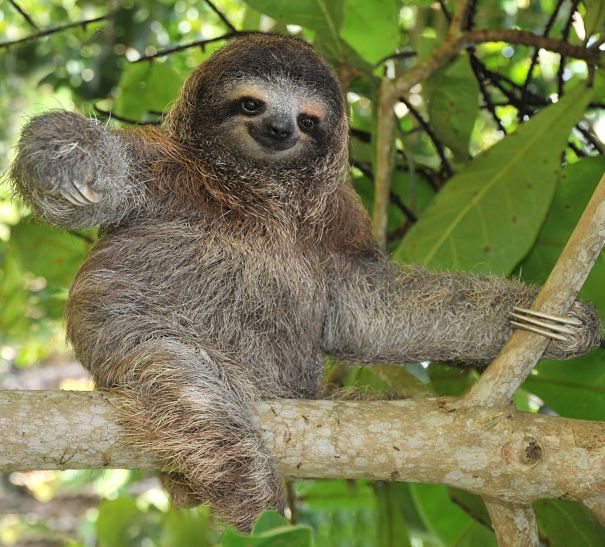

Much more or less than that and you’re in some serious trouble. Human body temperature averages at around 37☌, or 98.6☏, give or take about half a degree. This makes them a form of coprophagous, or “poop-eating” moths. These moths need the dung of the sloth in order to reproduce since they have come to lay their eggs in it. The algae that coat some sloths provides nutrients for five types of moth that can live only on the fur of sloths. These include beetles, ticks, mites and even moths, which we’ll come back to shortly. This algae not only provides nutrients for the sloth, but for a host of other organisms that live in its fur. The hair of a sloth is coated in a thick, green algae that aids in its camouflage. The closest relative to modern sloths is the anteater, a sort of insectivorous, terrestrial version of a sloth with equally formidable claws.Īnteaters are surprisingly adept climbers, too, so the two suborders can occasionally bump into one another. They can lose a third of their body weight letting it all out in one big go!īeing on the ground leaves the sloth vulnerable to predators, so they will (slowly) climb back into the tree afterwards. They will return to the same hole every week to defecate. They have a rather bizaree toilet routine, where they climb down from their tree, dig a whole in the ground and then poo in it – once a week only. This allows them to travel between islands, and by reducing their metabolism they’re even able to hold their breath for 40 minutes! 5. Their low muscle mass means they don’t readily sink, and can actually travel significantly faster in the water than on land. While a sloth is almost useless on the ground, and only really dares to spend time there when it needs to poo, they’re quite adept at swimming. Sloth are 3 times stronger than humansįrom the moment they are born they are able to lift their entire weight with a single arm and are three times stronger than the average human due to specialized muscle arrangements in their arms, which allows them to hang upside in trees all day.

They occasionally move for food, to find a mate, and they will climb all the way down a tree to defecate, but for almost all their lives, they’re happy just to be. While hanging upside-down for so long, you’d think they’d find something to do, but sloths are quite content just sleeping or chilling on a branch for almost the entire day. Two-toed sloths guard their young very vigilantly, while the three-toed variety has learned to ignore their children’s cries almost entirely.Ģ. One interesting difference is in their parental care. The differentiation comes from the number of claws on their forelimbs, and I think you can figure out which is which. This is misleading in some cases, as both groups have three claws on their feet. The six species of sloth are separated into two groups, defined by the number of claws they have. They come in two-toed and three-toed varieties The conservation status of the six species alive ranges from least concern, to vulnerable and one species is currently critically endangered. Two-toed sloths (more on this distinction later) are omnivorous and will eat insects, fruit and even small lizards as well. When a sloth does need to eat, all species will diet on the leaves of the cecropia, which are dioecious trees. There are six species of sloth in total from two families classified by the number of claws they have, and there are many more that are already extinct

It also has a number of other interesting adaptations to its unique lifestyle that set it apart from other animals in the area. Its metabolism is so slow that it hardly ever has to eat or defecate, and it has a host of commensal organisms that live with it, in its fur to keep it company. The sloth spends most of its time in a dream-like state, in some of the most beautiful habitats on earth, literally hanging around. In the jungles of Central and South America hangs a creature who really has figured out life. Really, really slow (4 meters per minute, on average) It’s also a tropical, tree-dwelling mammal that is known for being super lazy! The word comes from the Middle English for “without care” and is thought to amount in a loss of interest in life. It’s essentially a manifestation of laziness and a hesitance to further God’s plan. Sloth is one of the seven capital sins from the Catholic faith.


 0 kommentar(er)
0 kommentar(er)
